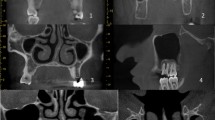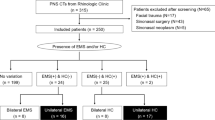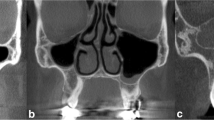Abstract
Objectives
The purpose of this study is to evaluate the prevalence of Haller Cell (HC) in a group of the Turkish population and to evaluate its relationship with accessory maxillary ostium (AMO) in presence of maxillary sinusitis.
Methods
621 CBCT images which were performed for various dental complaints between December 2015 and December 2017 were evaluated retrospectively. Presence of HC, AMO and maxillary sinus pathologies was analyzed. The Pearson’s Chi-square test was used between the groups.
Results
The incidence of HC in our patients was 7.73%. 36 female and 12 male patients with HC were found; thus, the female:male ratio was 3:1 (p < 0.05). Among 1242 maxillary sinuses, 61maxillary sinuses have HC (4.9%) which makes 27.1% of the HC as unilateral cases. 307 of the 1242 maxillary sinus had AMO (24.7%). The relationship between the presence of AMO and maxillary sinus pathology was found significant (p < 0.05); however, the relationship between HC and maxillary sinus pathology was not significant (p > 0.05).
Conclusion
Although HC is a possible predisposal factor, it is not a determinant for maxillary sinus pathologies per se.





Similar content being viewed by others
References
Mathew R, Omami G, Hand A, Fellows D, Lurie A. Cone beam CT analysis of Haller cells: prevalence and clinical significance. Dentomaxillofac Radiol. 2013;42(9):20130055.
Ahmad M, Khurana N, Jaberi J, Sampair C, Kuba RK. Prevalence of infraorbital ethmoid (Haller’s) cells on panoramic radiographs. Oral Surg Oral Med Oral Pathol Oral Radiol Endod. 2006;101(5):658–61.
Caversaccio M, Boschung U, Mudry A. Historical review of Haller’s cells. Ann Anat Anatom Anzeiger. 2011a;193(3):185–90.
Friedrich RE, Fraederich M, Schoen G. Frequency and volumetry of infraorbital ethmoid cells (Haller cells) on cone-beam computed tomograms (CBCT) of the mid-face. GMS Interdiscip Plast Reconstr Surg DGPW. 2017;6:Doc07.
Hussain A, Oestreicher J, Nijhawan N. Haller cells: a risk factor for spontaneous orbital floor fracture? Can J Ophthalmol. 2017;52(5):e185–8.
Ali IK, Sansare K, Karjodkar FR, Vanga K, Salve P, Pawar AM. Cone-beam computed tomography analysis of accessory maxillary ostium and Haller cells: prevalence and clinical significance. Imaging Sci Dent. 2017;47(1):33–7.
Bani-Ata M, Aleshawi A, Khatatbeh A, Al-Domaidat D, Alnussair B, Al-Shawaqfeh R, et al. Accessory maxillary ostia: prevalence of an anatomical variant and association with chronic sinusitis. Int J Gen Med. 2020;13:163–8.
Ghosh P, Kumarasekaran P, Sriraman G. Incidence of accessory ostia in patients with chronic maxillary sinusitis. Int J Otorhinolaryngol Head Neck Surg. 2018;4(2).
Sahin C, Ozcan M, Unal A. Relationship between development of accessory maxillary sinus and chronic sinusitis. Med J DY Patil Univ. 2015;8(5).
Jones NS. CT of the paranasal sinuses: a review of the correlation with clinical, surgical and histopathological findings. ClinOtolaryngol Allied Sci. 2002;27(1):11–7.
Yenigun A, Fazliogullari Z, Gun C, Uysal II, Nayman A, Karabulut AK. The effect of the presence of the accessory maxillary ostium on the maxillary sinus. Eur Arch Otorhinolaryngol. 2016;273(12):4315–9.
Matthews BL, Burke AJ. Recirculation of mucus via accessory ostia causing chronic maxillary sinus disease. Otolaryngol Head Neck Surg. 1997;117(4):422–3.
Orhan K, KusakciSeker B, Aksoy S, Bayindir H, Berberoglu A, Seker E. Cone beam CT evaluation of maxillary sinus septa prevalence, height, location and morphology in children and an adult population. Med Princ Pract. 2013;22(1):47–53.
Aksoy U, Orhan K. Association between odontogenic conditions and maxillary sinus mucosal thickening: a retrospective CBCT study. Clin Oral Investig. 2019;23(1):123–31.
Caversaccio M, Boschung U, Mudry A. Historical review of Haller’s cells. Ann Anat. 2011b;193(3):185–90.
Earwaker J. Anatomic variants in sinonasal CT. Radiographics. 1993;13(2):381–415.
Ghosh D, Baruah DK, Goswami SC, Basu SK. Lateral rhinotomy for a large, infected haller cell causing proptosis Philippine. J Otolaryngol Head Neck Surg. 2015;30:43–6.
Kamdi P, Nimma V, Ramchandani A, Ramaswami E, Gogri A, Umarji H. Evaluation of haller cell on CBCT and its association with maxillary sinus pathologies. J Indian Acad Oral Med Radiol. 2018;30(1):41–5.
Jahandideh H, Yarahmadi A, Rajaieh S, Shirazi AO, Milanifard M, Yarahmadi A. Cone-beam computed tomography guidance in functional endoscopic sinus surgery: a retrospective cohort study. J Pharm Ree Int. 2020;31(6):1–7.
Mladina R, Vukovic K, Poje G. The two holes syndrome. Am J Rhinol Allergy. 2009;23(6):602–4.
Acknowlegement
We would like to recognize the assistance that we received from Dr. Sedef Ayşe Taşyapan and Dr. Beliz Güray.
Author information
Authors and Affiliations
Corresponding author
Ethics declarations
Conflict of interest
Author Özcan, Author Göksel, and Author Çakır-Karabaş, Author Ünsal declare that they have no conflict of interest.
Human rights statements
All procedures followed were in accordance with the ethical standards of the responsible committee on human experimentation (institutional and national) and with the Helsinki Declaration of 1964 and later versions.
Informed consent
Informed consent was obtained from all patients for being included in the study.
Additional information
Publisher's Note
Springer Nature remains neutral with regard to jurisdictional claims in published maps and institutional affiliations.
Rights and permissions
About this article
Cite this article
Özcan, İ., Göksel, S., Çakır-Karabaş, H. et al. CBCT analysis of haller cells: relationship with accessory maxillary ostium and maxillary sinus pathologies. Oral Radiol 37, 502–506 (2021). https://doi.org/10.1007/s11282-020-00487-2
Received:
Accepted:
Published:
Issue Date:
DOI: https://doi.org/10.1007/s11282-020-00487-2




